Bad news for Cathay Pacific Asia Miles collectors: the program will be removing one of its most generous policies – the free stopover on a one-way award – as of April 1, 2020.
If you’d like to book some of the most compelling sweet spots within the program (not to travel during the upcoming few months, of course, but rather for late 2020 or early 2021), you have just over a week’s time to take advantage.
The Rule Change
You’ll find notice of this change posted on the Latest News section of the Asia Miles website, under a March 20 entry named “New Flight Award rules and fees”. In particular, Item #2 on the list reads:
New duration limit for stopovers
Stopover duration will now be limited to a maximum of 24 hours for Asia Miles Awards and Airline Partners Awards. Please note that all waitlist bookings made before 1 April 2020 are bounded by this change.
For example, if you redeem an itinerary with Cathay Pacific from Taipei to Bangkok, transiting through Hong Kong, the maximum duration for your stopover in Hong Kong is 24 hours. If the duration is more than 24 hours, you are required to make two separate bookings, with Taipei to Hong Kong as the first booking, and Hong Kong to Bangkok as the second.
As a reminder, one-way awards booked using Asia Miles’s regular award chart are limited to two segments, while round-trip awards are limited to four segments.
Until now, when booking a one-way, it has been possible to build in a stopover of up to one year in duration at the intermediate point between your two segments.
As of April 1, there will be a “duration limit” of 24 hours on the stopover, but what this really means in the common parlance is that stopovers of extended duration will no longer be allowed, and you’ll be restricted to a 24-hour layover at the intermediate point instead.
If we refer to my previous post on some of the best Asia Miles sweet spots, we see that many of the sweet spots are taking advantage of the stopover on a one-way.
For example, you’re able to redeem 85,000 Asia Miles for a one-way flight from North America to Hong Kong to Europe, with an extended stopover in Hong Kong – essentially making it three-quarters of the way around the world for only 85,000 miles, which is a tremendous deal.
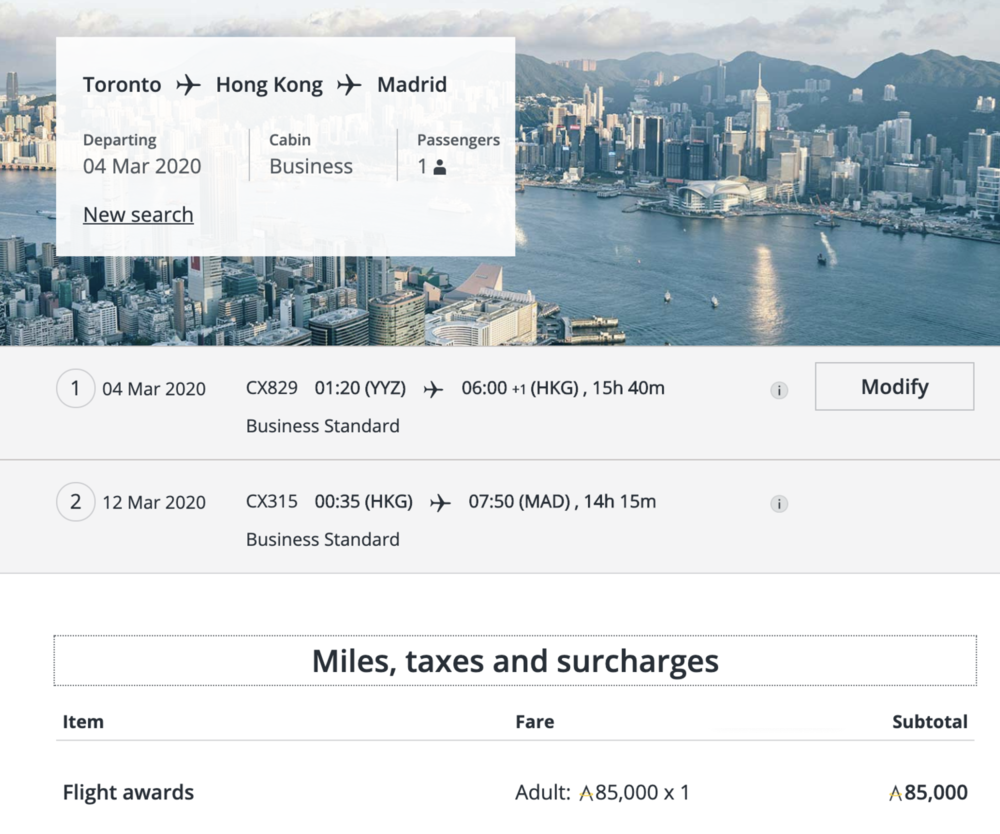
Under the new rules, you’ll only be have a long layover in Hong Kong, not a stopover of extended duration. If you’d like to stop in Hong Kong for a while, you’d need to book two separate awards, which would cost you a far greater number of miles.
(I myself recently took advantage of the one-way with stopover when I booked Tokyo–Doha–Montreal on Qatar Airways Qsuites with a six-day stopover in Doha along the way. That particular redemption won’t be on the table anymore, although Tokyo–Doha–Montreal, even without a stopover, for 90,000 Asia Miles and very low fees remains a very good deal.)
Note that this new rule only applies to bookings made under the regular Asia Miles award chart, which is shown here (with a few footnotes below):

-
The award chart applies to any one-way itineraries entirely on Cathay Pacific or Cathay Dragon. For itineraries involving one additional airline partner, the price will be 5,000 miles higher (for economy, premium economy, or business) or 10,000 miles higher (for First Class).
-
There’s one exception: for business class partner awards in the “Medium” distance band, the mileage cost is 61,000 miles instead of 50,000 miles
-
-
Mixed-cabin awards are priced based on an average of the mileage cost for the two cabins of service, weighted by the flown distances of the respective flights.
If you’d still like to book stopovers using your Asia Miles going forward, a more economical option would be to use the Asia Miles Oneworld multi-carrier award chart, which applies when two or more Oneworld partner airlines are involved.
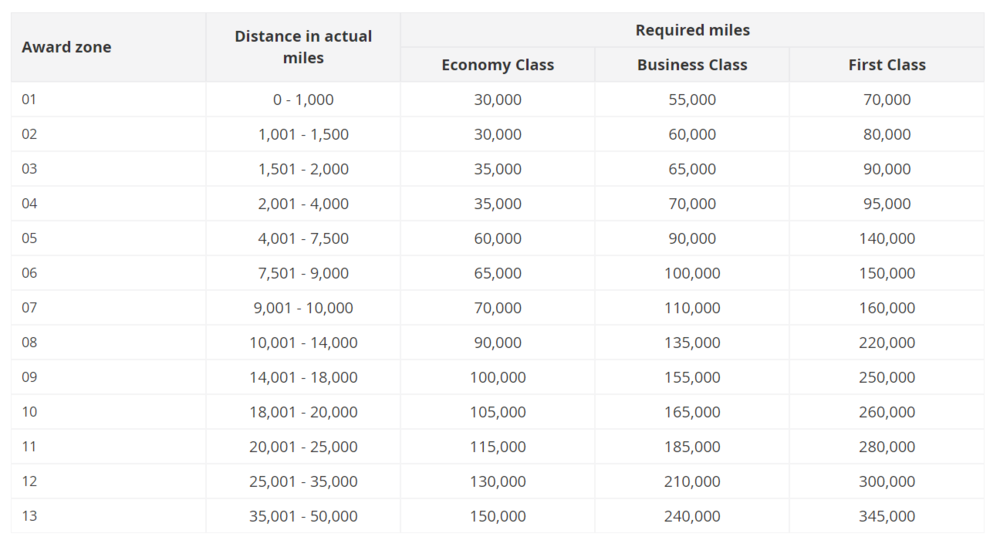
The mileage amounts are generally going to be higher than the simple one-way with stopover, but it’ll be cheaper than booking two separate awards, and Asia Miles has even recently optimized their website to make Oneworld multi-carrier awards searchable and bookable online.
Last Chance to Book “Kinky One-Ways”
Until now, one of the most lucrative hidden sweet spots within the Asia Miles program was the ability to book “kinky one-ways” using the fact that you’re allowed to have a stopover on a one-way redemption.
How can a one-way flight be “kinky”, you ask? Well, take a look at this itinerary on a map:

See the kink?
You fly Cathay Pacific business class from Toronto to Hong Kong, enjoy a stopover of, say, two weeks there, and then fly back to New York JFK on Cathay business as well.
Most other programs would treat this type of redemption as a round-trip with an open-jaw, but under a distance-based program with lax routing rules like Asia Miles, this is in fact a one-way redemption with a stopover.
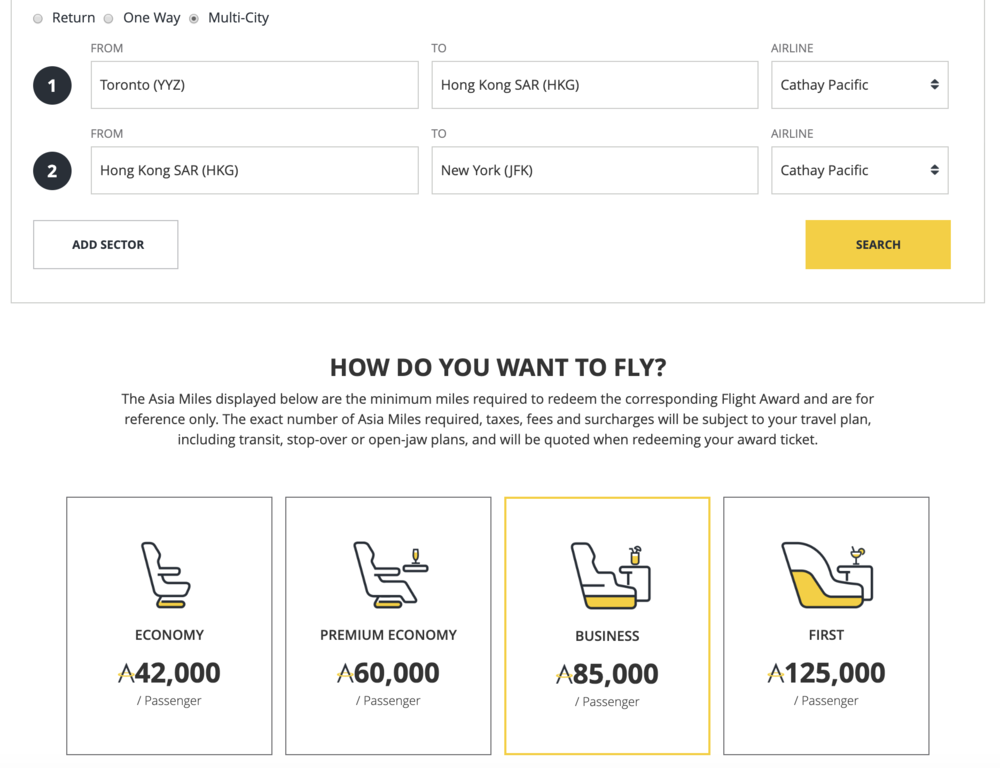
And as with any other one-way redemption, if the total distance flown is in the “Ultra-Long” band at 7,501+ miles, you get charged 85,000 Asia Miles for it (plus about $300 in taxes and fees). The value here should be clear for all to see.
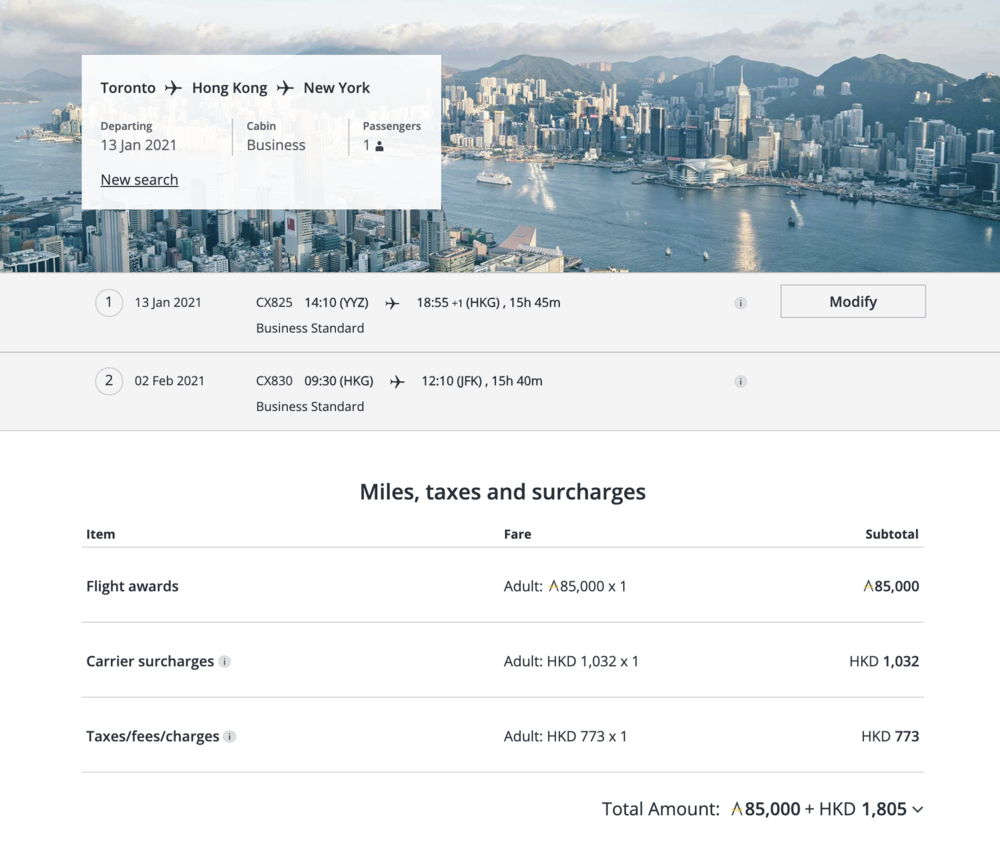
This type of pseudo-round-trip flight works with pretty much any part of Oneworld’s collective route network. For example, until April 1, you could book all of the following with a “stopover” at the intermediate point:
-
Vancouver–Hong Kong–Seattle in Cathay Pacific business class for 85,000 Asia Miles
-
London–Hong Kong–Paris in Cathay Pacific business class for 85,000 Asia Miles, or Cathay Pacific First Class for 125,000 Asia Miles
-
Los Angeles–Tokyo–Vancouver in Japan Airlines business class for 90,000 Asia Miles, or a mixed itinerary in Japan Airlines First Class & business class for roughly 110,000 Asia Miles
-
Montreal–Amman–New York in Royal Jordanian business class for 90,000 Asia Miles
-
Montreal–Doha–New York in Qatar Airways Qsuites for 90,000 Asia Miles (although the fuel surcharges will be quite high)
(Of course, these examples assume that any currently suspended routes will be up and running again towards late 2020 or early 2021.)
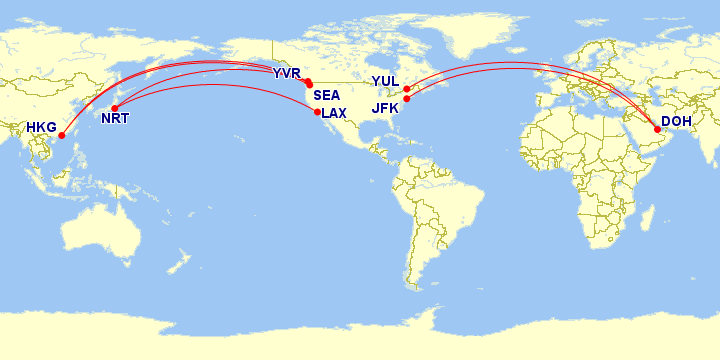
Note that the kinky one-ways are only valid when the two endpoints are in separate jurisdictions, because cabotage laws forbid a foreign carrier from transporting passengers between two points in the same country (even if there’s a stopover at an intermediate point halfway around the world). So something like Toronto–Hong Kong–Vancouver on Cathay Pacific, for example, would not be valid.
If you have any need to travel to Asia over the upcoming year, and are comfortable banking on the fact that global travel might resume by late 2020 or early 2021, then it could definitely worth securing a Toronto–Hong Kong–New York or Vancouver–Hong Kong–Seattle (or vice versa) booking for 85,000 Asia Miles before April 1 – especially given the relative abundance of award availability that we’re seeing at the moment.
Asia Miles levies a fee of US$25–100 for changing or cancelling an award flight (depending on whether you’re only changing the date, or the entire routing); moreover, remember that you can change your flight to within one year of the original ticketing date (if the first flight has not commenced), or to within one year of the first flight taking place (if travel on the first flight has already commenced).
Therefore, assuming that the current stopover policy applies even if you need to make changes after April 1, you could in theory book travel for well into 2021 and even into 2022 under this sweet spot, as long as you make the booking prior to April 1.
Conclusion
The stopover on a one-way award has been one of the most generous features within the Cathay Pacific Asia Miles program, and it’s a shame to see it go.
There’s still just over a week to take advantage of the amazing opportunity to book what is effectively a round-trip business class flight for a one-way price, so if you’ve been collecting Asia Miles with the goal of travelling to Asia anytime in the next few years, now’s the time to take action.
Otherwise, plenty of value will still remain in Asia Miles going forward – for example, Toronto–Hong Kong–Sydney for 85,000 miles in business class is a very good deal, even without the intermediate stopover – but there’s no doubt that a lot of value will have been stripped away.








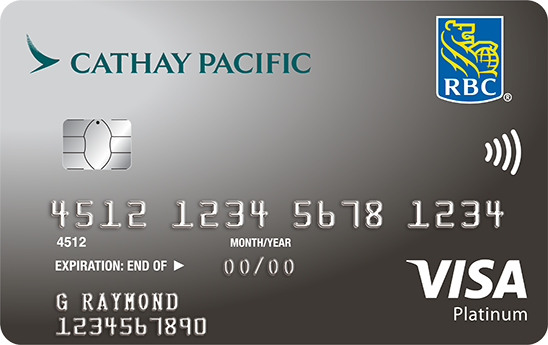









Hi Ricky,
When calling into Cathay Pacific, they (the phone rep and escalated to a manager) advised that Roundtrip redemption tickets DO NOT offer stopovers. You can ONLY stop at the final destination. Layovers are allowed up to 24 hours.
Hi, I suspect Cathay has quietly removed the stopover feature of their roundtrip award ticket. As I could not find any mention of stopover in their Terms & Condition anymore. Cathay has revamped their award chart recently, that was when they might have changed it. If I see otherwise, I’ll report back!
Were you able to book the Qatar Tokyo-Doha-Montreal flight online or did you have to call in? I keep getting errors if I try to book to other cities in North America.
Dead. Midnight HK time.
Got a kinky YVR-HKG-LAX for 2 booked, thanks to you!
Have a kinky time! 🙂
Hi! Can I use Avios to redeem Cathay Pacific flights like those kinky one-ways ????. Merci!!
Not really, because Avios would charge you the full mileage amount for both directions. The value here is that the Asia Miles award chart "maxes out" at the Ultra-Long distance band, charging the same amount for a 7,501-mile journey as a 15,000+ mile journey.
The article frames this as losing the ability to have a stopover on a one-way award, but the new T&C language doesn’t specifically mention one-way awards. It says no more stopovers, period. Just wanted to confirm that you can’t have a stopover on a round-trip award now either or if i’m missing something. Thanks!
Correct, it applies to round-trips as well. The emphasis is one the one-way with stopover because that’s been the most popular and flexible use of Asia Miles.
Got it, thank you
"Therefore, assuming that the current stopover policy applies even if you need to make changes after April 1, you could in theory book travel for well into 2021 and even into 2022 under this sweet spot, as long as you make the booking prior to April 1. "
Where does it say that you can further change your dates and extend your ticket validity for another year into 2022?
A ticket can be changed to within one year of the first segment if the first flight has already commenced. So if you made a booking for say January and February 2021, flew the first segment, and then changed the second segment, you’d be able to change it all the way into January 2022.
I wonder if this trick could be used to effectively get this stopover even after the rules change…e.g. book a trip with a standard 18-hour layover or whatever, then move the second flight after flying the first flight?
Would the kinky miles trick also applies to redemption using Alaska miles?
They’ve tightened up on most of them, but there are still a few left, like this one: https://princeoftravel.com/blog/an-emirates-first-class-extravaganza
Thanks Ricky!
Just to confirm Alaska Miles allows a stopover on one way redemption i.e. YYZ – HKG (stopover) – YYZ, so after April 1st this stopover on one way still valid? Is this correct?
This wouldn’t be a one-way, though, it would be a round-trip. A one-way with Alaska is something like YYZ–HKG–JNB or YYZ–HKG–TLV, with a stopover in HKG. You wouldn’t be able to head back to North America on a "kinky" one-way.
Yes. My bad. I meant YYZ-HKG-JNB or something like that so stopover still available with Alaska one way redemption after April 1st?
Yes, that’s not changing.
Is a waitlist booking different from a regular booking? Where as if you book a flight before April 1 the stopover could be longer or 24 hours for any booking. Also will the kinky miles be going away on that date?
The Asia Miles statement on the rule change mentions that waitlist bookings will be subject to the new stopover rules if they clear after April 1 – that is to say, you won’t be allowed to book the ticket if your waitlist doesn’t clear before then.
I’d recommend securing a confirmed booking, not a waitlisted one, before that date.
Can you book using economy, and then upgrade to business/first and retain the stopover? Thanks!
I would think so.
I too would love to know this, I have enough points for 1/2 business tickets for me and P2.
Does this change remove the last remaining sweet spot for CX? Aside from their "regular" redemptions which may or may not make sense (eg NRT-DOH-YUL without a stopover)
The most interesting sweet spot (the kinky one-way flights) are ending. Other sweet spots, like mixed-cabin itineraries being priced as a weighted average, remain in play for now.
Wide open just managed to book through a pair to Male with layover in Hong Kong . Male was never ever available in businessbac. Then Turkish all the way back to YVR through Mauscat Oman in business on the new direct flight. If you have the points now is the time to pull the trigger.
Nicely done – although I’d point out that you can still book Canada–Hong Kong–Male for a pretty good price after the April 1 rule change, if it’s only a layover in Hong Kong.